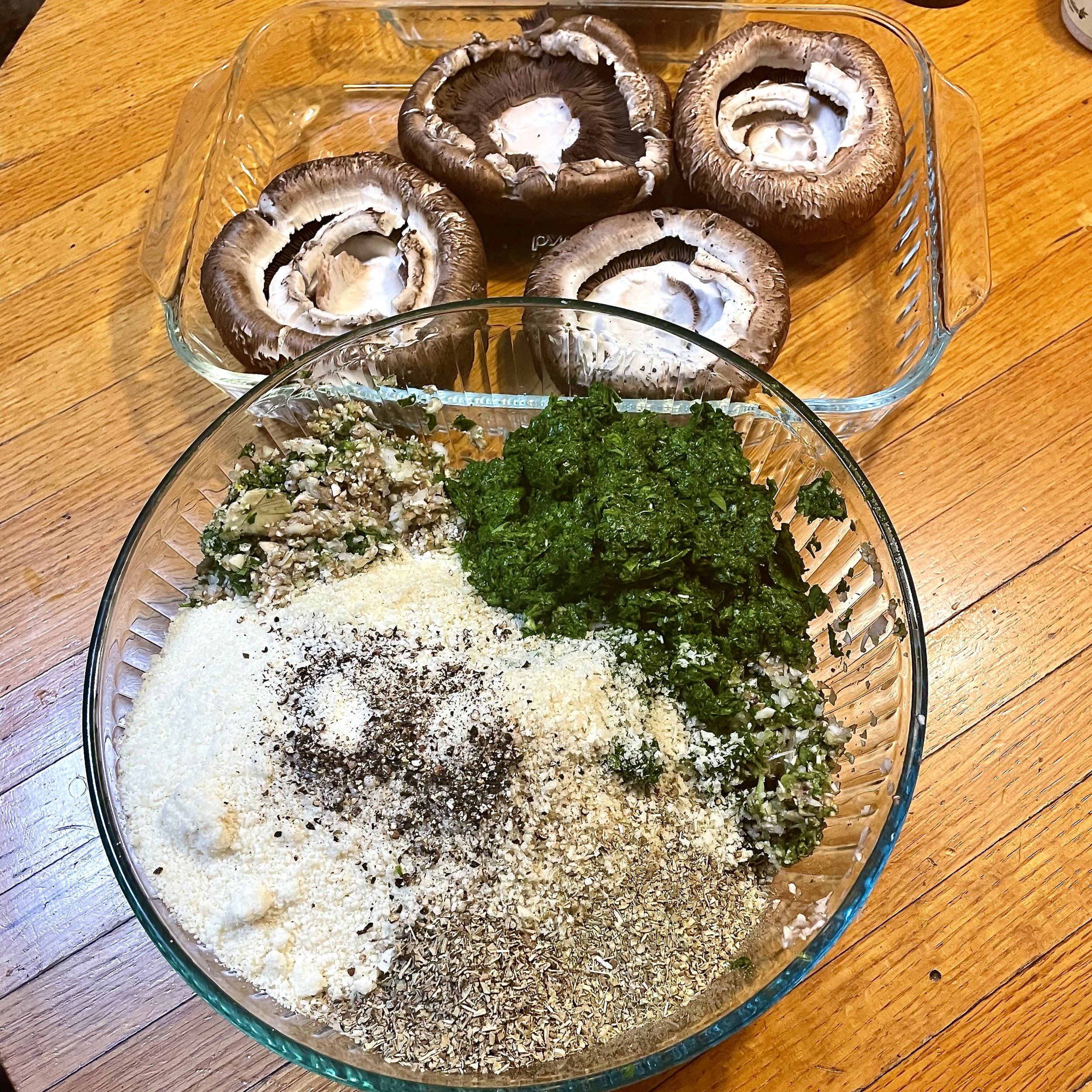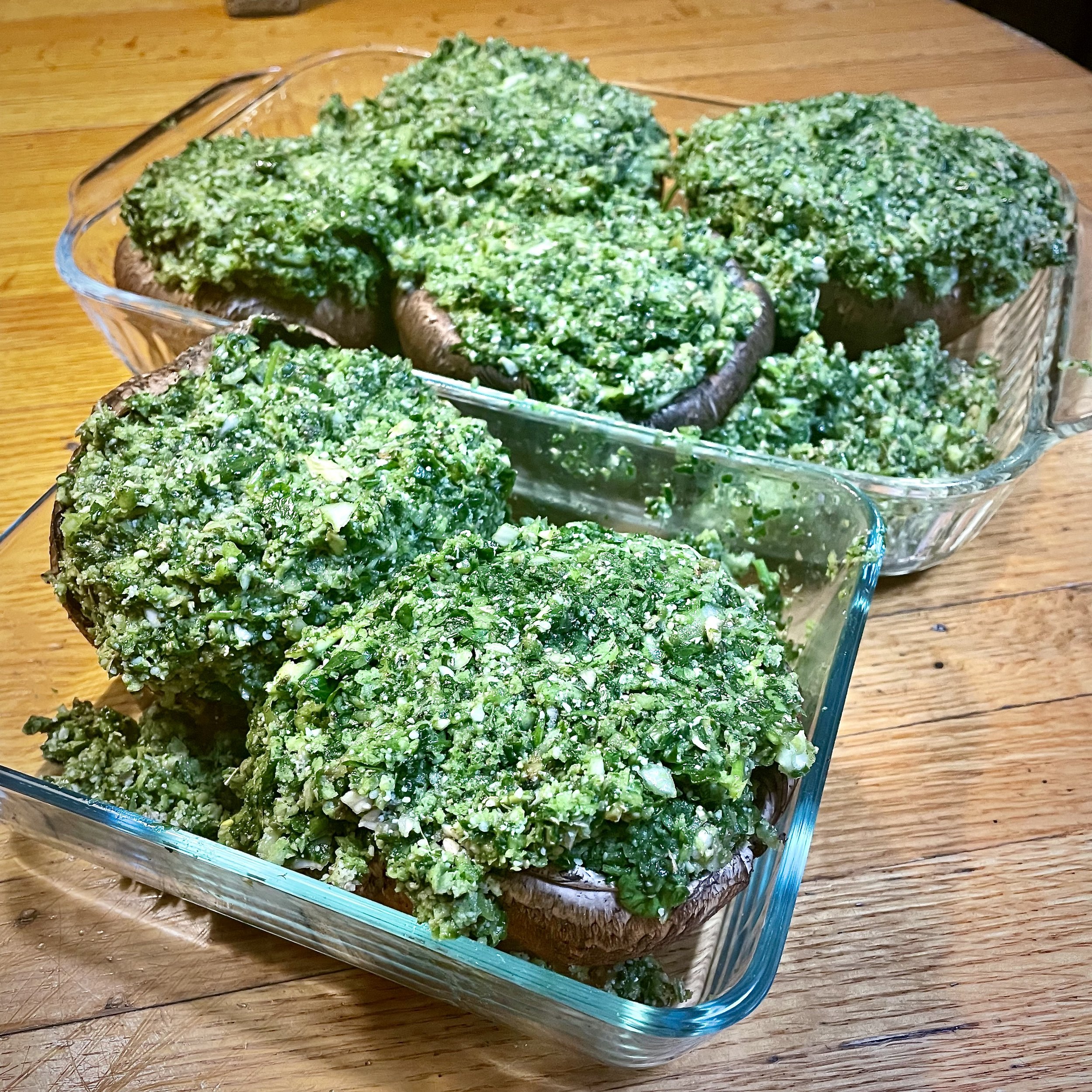History
Portobello mushrooms are mature Agaricus bisporus fungi. Their young form is the common white button mushroom which matures into the cremini mushroom. Native to the grasslands of Asia, Europe, and North America, portobellos were first grown commercially in the early 18th century. Due to growing inconsistencies, there was not much incentive to propogate them until 1893 when developments in horse manure sterilization, by the Paris-based Pasteur Foundation, created a more consistent factor in the growing process, and coined the French term for the portobello, champignon de Paris or Paris mushroom. This stability factor was crucial in a growing process that naturally has many fluctuating factors. All Agaricus bisporus mushrooms were all gray until a mutation created white mushrooms in 1925 in Pennsylvania, and most white mushrooms available today descend from this one mutation.
White mushrooms and white bread rode together into popular American cuisine with their novelty factor as accessible luxuries, establishing their place in everyday kitchens across the country. Growing up in 1980s New England, getting an iceberg lettuce salad with raw mushrooms was a special treat. We’d have them occasionally but I associate them most with stuffed mushrooms for parties, not as much in day to day cooking. Of the three maturities, portobellos were especially unpopular on the general market at this time as they were considered ugly and unappealing. Eventually, portobellos became popular with chefs and home cooks and then, there was no stopping this Agaricus bisporus. Today, China far surpasses any other country’s production of Agaricus bisporus, followed by Japan, the United States, Poland, and the Netherlands.
The umami flavor and toothsome texture made portobello mushroom burgers a popular trend for many years in the 1990s and 2000s. In the last two decades, mushrooms have been reconsidered as a sustainable, nutritious food source that has regularly put them on food trend lists considering both the environment and culinary creativity. Mushrooms, though available year round, are a winter food, and they are ideal for countering the cold, wet, stagnation of winter. Now I know why eating mushrooms in Ireland was such a delectable experience — they were the perfect culinary match for a cool, rainy climate.
Nutrition and Energetics
Agaricus bisporus reduces pitta and kapha, and are sweet and cooling. They absorb fat in the blood, increasing their appeal to those concerned with cardiovascular health. They also absorb excess mucus in the respiratory tract, easing winter congestion. Their nutritional profile, high in protein, B vitamins, especially riboflavin (B2), pantothenic acid (B5), niacin (B3), phosphorus, and low in fat and calories made Agaricus bisporus appealing to both the health and waist-conscious.
It’s interesting that they are cooling in their energetics and aid adaptability to cool, wet climates. Agaricus bisporus increases production of white blood cells, signaling the hypothalmus to increase body temperature. With eating mushrooms, this happens subtly, not enough to feel feverish, but enough to help balance excess seasonal coolness. Agaricus bisporus are also immunity boosting in their antibiotic action.
I wonder about Agaricus bisporus modulators of body temperature considering that besides their capacity to balance coolness, they also can remove excess heat due to high animal protein consumption. This action helps orient us to their purpose in the wider lens of ecosystems — to eat what is decaying, return those nutrients in a more available form back to the earth, facilitating the turn from life to death to life again. These digesting and distributing aspects are relevant to where we are in our relationship as humans to the planet. Will we abandon our models of infinitely expanding growth for ones that are more cyclical in nature, ones that are modeled by nature? Mushrooms have long been an area of research for supporting a positive adaptogenic response and taming the uncontrolled growth of cancers. Mushrooms, and Agaricus bisporus as the most common form of mushroom available, remain an exciting inspiration for chefs, for health enthusiasts, and for scientific research, in reflecting on steps forward that can be delicious, sustainable, and balancing, a topic fertile for much reflection on how to step forward consciously, taking in the perspective of an interconnected network, an entire ecosystem. Could mushrooms even have the potential to help us shift from an individual to a collective mentality? Let’s eat more and find out.
And that’s the thing, mushrooms can be so satisfying! This recipe has a lot more greens and aromatics than classic stuffed mushrooms (think cracker crumbs and lots of butter). Parsley, Petroselinum crispus, is a digestive aid, diuretic, warming, blood purifying, stimulates bowels, and freshens breath. Spinach, Spinach oleracea, supports the stomach, large intestine, liver, and reduces kapha. Garlic, Allium sativum, is pungent, warming, stimulating, antibacterial, antifungal, anticarcinogenic, antiparasitic, aids blood pressure, cholesterol levels, spleen pancreas, stomach, kidney, lungs, and promotes healthy gut flora. Onion, Allium cepa, is antioxidant, anticarcinogenic, antiviral, antibiotic, aids kidneys, healthy cholesterol levels, and increases appetite. Raw onion reduces kapha, while cooked onion reduces kapha and pitta. This recipe was created with flavor and winter adaptability in mind.
A Couple of Recipe Notes
Other mushroom varieties like shiitake could be used for all or some of the cremini mushrooms for even more immune-boosting nutrient density.
Breadcrumbs or cracker crumbs can be substituted for the panko, and of those options, panko is the lightest.
Vegan and Gluten Free options are included below.
The mushrooms can be prepped a day ahead, keeping the filling in an air tight container and the mushroom tops in the glass pans or a paper bag.
One last thing before the recipe.
I have a special bond with portobellos because stuffed portobellos were the first menu item I was allowed to make independently in my first professional cooking job as a teenager. Preparing 30 cases of portobellos a day bled into my dreams, and waking and dreaming, I made these mushrooms until I could literally and figuratively make them in my sleep. Not only did I make some kick ass stuffed mushrooms, but from this experience I learned about kitchen process, mise en place, and listening to your ingredients through sensory observation, physical touch, and intuition. For this initiation process, I will always have a unique and adoring spot in my heart for portobellos. I hope you enjoy this recipe!
Ingredients
2 tablespoons olive oil, optional= more for drizzling on top
6 huge or 8 large portobellos
2 medium onions
1 medium head, about 10 cloves Garlic
2 cups cremini mushrooms
1 large bunch parsley
8 cups spinach (another green like kale or collards could be used here, though spinach has a more delicate flavor and texture)
2 cups panko (For GF option see below*)
1 1/2 cups grated mix parmesan and romano cheese (For Vegan option see below**)
Optional: 1/2 cup extra cheese for topping
2 tablespoons dried basil
1 tablespoon dried oregano
a sprinkle sea salt, more to taste
1/2 tsp black pepper, more to taste
Procedure
Preheat oven to 350F.
Separate the portobello tops and stems.
Trim bottoms of stems and anything darker brown or slimy. Add these to the cremini mushrooms.
Clean portobello tops, washing or wiping with a damp cloth.
Drizzle 1 T olive oil in 2- 8x8 glass baking dishes. Add the portobellos to the oiled baking dishes.
Trim cremini stems. Wash all creminis and portobello stems.
Prep onions, garlic, spinach, and parsley for the food processor:
Peel onions, cutting each one into half, then into 4-6 pieces. Set aside.
Peel garlic. Set aside.
Trim parsley stems, rough chop bunch with 4 cuts. Wash parsley in a salad spinner. Set aside.
Trim spinach ends. Wash well, always wash spinach at least twice if not three times because it holds the dirt well. Set aside.
Pulse creminis, portobello stems, onions, garlic, parsley, and spinach in the food processor in stages, combining all that’s been processed in a large bowl.
Add salt, pepper, cheese, panko, basil, and oregano. Mix well.
Divide the mixture between the portobellos, generously topping each and pressing down slightly to firm the topping on the portobellos. Any extra topping mix can be placed in the pans next to the mushroom tops.
Optional: top with extra cheese and or some olive oil.
16. Bake one hour at 350F.
17. Turn down the oven to 275F, and bake for another 30 minutes.
Serving suggestions:
Eat them as they are, alongside a salad, or on top of pasta.
Here is a stuffed mushroom on top of arugula, fusilli, and topped with homemade tomato sauce.
*Gluten Free Option:
Use 1 1/2 cups ground flax seed and 1/2 cup ground nut/seed.
**Vegan Option:
For the cheese, sub 1 cup ground nuts or seeds like sunflower, cashew, walnut, or almond with 1/2 cup nutritional yeast.







